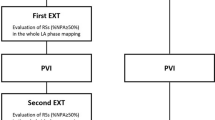Abstract
Objective
We have previously shown that up to one-third of patients develop no change or an increase in sinus node cycle length (SNCL) during ventricular fibrillation (VF). The purpose of the present study was to investigate the mechanism of SNCL changes during VF in a swine model. We hypothesized that changes in SNCL during VF are vagally-mediated.
Methods
In 33 anesthetized pigs DC current was used to induce VF for 10 s followed by defibrillation. SNCL changes were assessed during VF and compared to baseline. Animals that had ventriculo-atrial conduction during VF were excluded. Post-defibrillation, the pigs were randomized to receive atropine, propranolol, atropine + propranolol or placebo followed by repeat VF induction and measurement of SNCL changes.
Results
Ventriculo-atrial conduction was present in 14 pigs prohibiting SNCL measurements. In the remaining 19 animals, 10 demonstrated SNCL shortening (S-Group) and 9 demonstrated non-shortening (NS-Group). Atropine decreased the absolute change in SNCL from 51.2 to 26.6 ms (n = 6; p = 0.03). It attenuated the SNCL shortening previously observed in the S-Group (−99.2 ms versus −47.9 ms, p = 0.04) and reversed the SNCL prolongation initially observed in the NS-Group (27.1 ms versus −6.5 ms, p = 0.13). Similarly, atropine + propranolol decreased the absolute change in SNCL from 33.3 to 12.2 ms (n = 4; p = 0.05). No significant changes were noted with propranolol or placebo.
Interpretation
The SNCL changes during VF appear to be vagally-mediated. The clinical implications vis-à-vis defibrillation threshold and future device programming await future studies.



Similar content being viewed by others
References
Wasmund SL, Pai RK, Freedman RA, Abedin M, Daccarett M, Segerson NM, Zaitsev AV, Hamdan MH (2009) Modulation of the sinus rate during ventricular fibrillation. J Cardiovasc Electrophysiol 20:187–192
Committee for the Update of the Guide for the Care and Use of Laboratory Animals (1996) Guide for the care and use of laboratory animals. The National Academies Press, Washington, DC
Adlan AM, Lip GY, Fadel PJ, Fisher JP (2013) Sympathetic nerve activity during non-sustained ventricular tachycardia in chronic heart failure. Int J Cardiol 165:e15–e17
Smith ML, Ellenbogen KA, Beightol LA, Eckberg DL (1991) Sympathetic neural responses to induced ventricular tachycardia. J Am Coll Cardiol 18:1015–1024
Smith ML, Joglar JA, Wasmund SL, Carlson MD, Welch PJ, Hamdan MH, Quan K, Page RL (1999) Reflex control of sympathetic activity during simulated ventricular tachycardia in humans. Circulation 100:628–634
Smith ML, Kinugawa T, Dibner-Dunlap ME (1996) Reflex control of sympathetic activity during ventricular tachycardia in dogs: primary role of arterial baroreflexes. Circulation 93:1033–1042
Hamdan MH, Joglar JA, Page RL, Zagrodzky JD, Sheehan CJ, Wasmund SL, Smith ML (1999) Baroreflex gain predicts blood pressure recovery during simulated ventricular tachycardia in humans. Circulation 100:381–386
Wall TS, Wasmund SL, Freedman RA, Akoum NW, Page RL, Hamdan MH (2015) “Vasovagal” response during ventricular fibrillation: incidence and implications. Pacing Clin Electrophysiol 38:376–382
Belardinelli L, Belloni FL, Rubio R, Berne RM (1980) Atrioventricular conduction disturbances during hypoxia. Possible role of adenosine in rabbit and guinea pig heart. Circ Res 47:684–691
Huikuri HV, Zaman L, Castellanos A, Kessler KM, Cox M, Glicksman F, Myerburg RJ (1989) Changes in spontaneous sinus node rate as an estimate of cardiac autonomic tone during stable and unstable ventricular tachycardia. J Am Coll Cardiol 13:646–652
Author information
Authors and Affiliations
Corresponding author
Rights and permissions
About this article
Cite this article
Wasmund, S.L., Pacchia, C.F., Page, R.L. et al. Mechanisms of sinus node cycle length changes during ventricular fibrillation. Clin Auton Res 25, 399–406 (2015). https://doi.org/10.1007/s10286-015-0319-5
Received:
Accepted:
Published:
Issue Date:
DOI: https://doi.org/10.1007/s10286-015-0319-5




